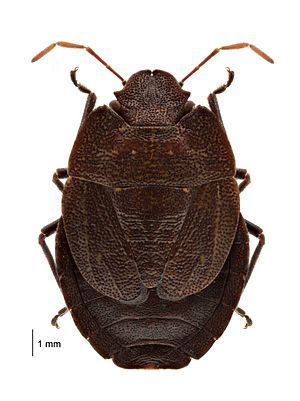Hypsithocus hudsonae facts for kids
Quick facts for kids Hypsithocus hudsonae |
|
|---|---|
 |
|
| Dorsal view | |
| Scientific classification | |
| Genus: |
Hypsithocus
|
| Species: |
hudsonae
|
The Hypsithocus hudsonae, often called the alpine shield bug or black alpine shield bug, is a unique insect. It's a type of shield bug that can't fly. This bug is found only in New Zealand, meaning it is endemic to that country. Scientists have not found many of these bugs, and they all come from a small area. The New Zealand Department of Conservation says this species is 'At Risk'. This means we don't have much information about it, and it lives in a very small area.
What Does the Alpine Shield Bug Look Like?
The alpine shield bug (H. hudsonae) is dark brown. It is about 7 to 9 millimeters long, which is less than half an inch. Its body is oval-shaped and quite flat. Young alpine shield bugs, called nymphs, look a lot like the adults. However, the edges of their bodies are a lighter brown color. This bug is the only type of shield bug in New Zealand that cannot fly.
Life Cycle of the Alpine Shield Bug
Like many other shield bugs, the alpine shield bug starts its life as an egg. After hatching, the young bugs are called nymphs. These nymphs grow through five different stages, known as instars. Each instar is a period between molts, when the bug sheds its outer skin to grow bigger. After the fifth instar, the nymph becomes a full-grown adult bug. The adults likely mate in the summer. It is thought that these bugs have only one group of babies (brood) each year.
Where Do Alpine Shield Bugs Live?
Scientists have only found alpine shield bugs in a few mountain areas. These places are in Central Otago, New Zealand. They live at high altitudes, between 1200 and 1700 meters (about 3,900 to 5,600 feet) above sea level. The reason they live in such a small area might be because they can't fly. Since adults can't fly, they can't easily move to new places.
The alpine shield bug is a herbivore, which means it eats plants. These bugs have been found on a plant called Hebe odora. This suggests that Hebe odora might be one of the plants they like to eat.

